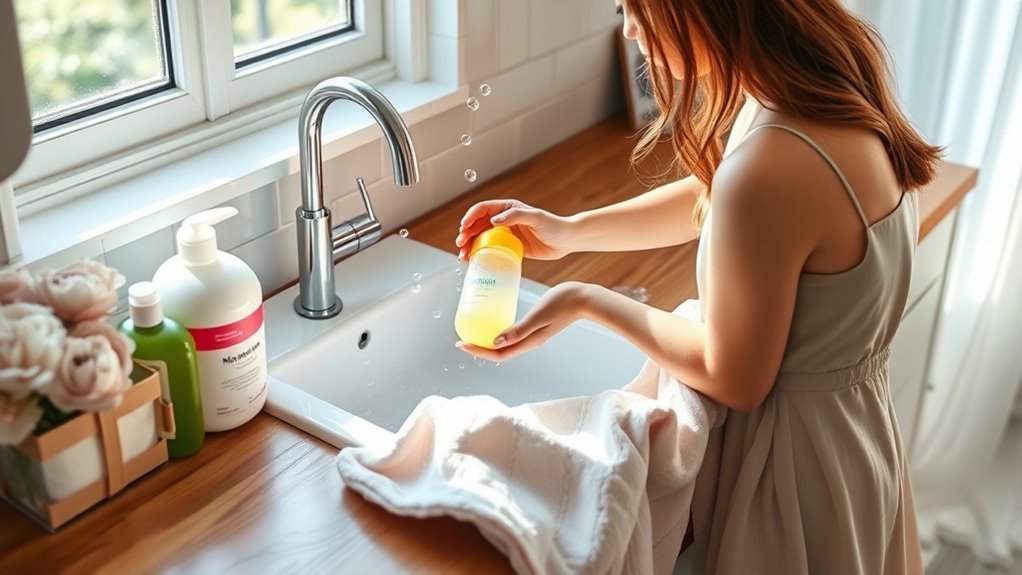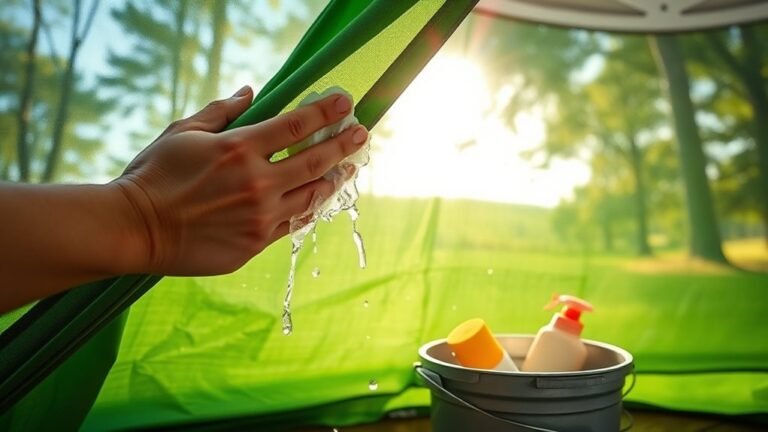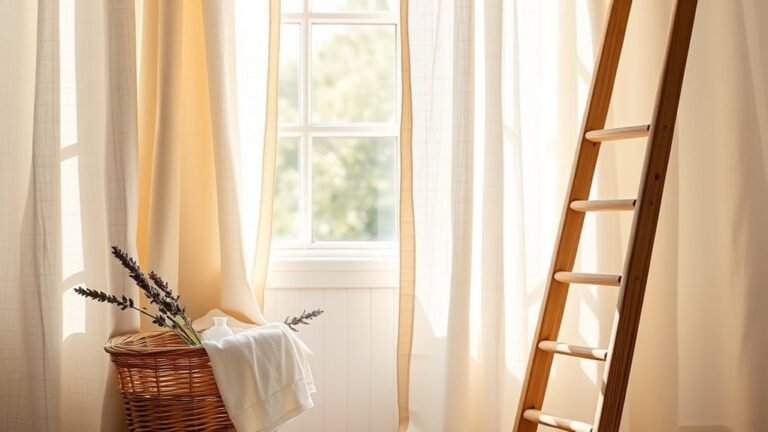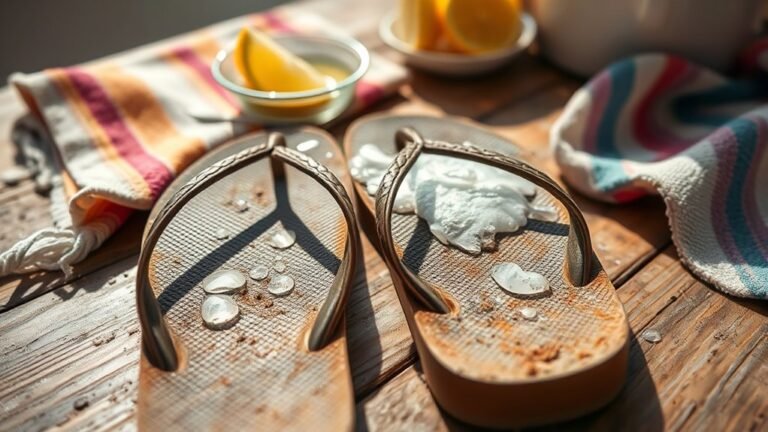How to Clean Your Baby Items Safely
To clean your baby’s items safely, rinse bottles right after use and wash all parts with warm, soapy water, then sterilize by boiling or steam. Sanitize toys with baby-safe wipes or boiling water, and wash clothes using mild, hypoallergenic detergent. Keep bedding fresh by washing regularly with gentle products and choose plant-based or natural cleaners free from harsh chemicals. Following these simple steps protects your baby’s health and keeps their environment clean, with more helpful tips waiting if you want to keep things extra safe.
Cleaning Baby Bottles and Feeding Accessories
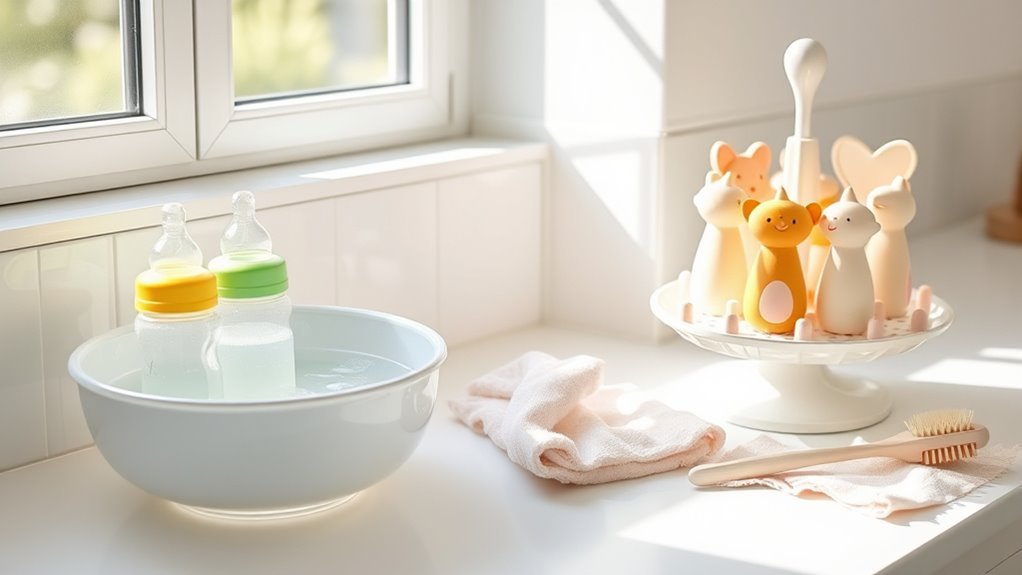
When cleaning baby bottles and feeding accessories, you’ll want to rinse them immediately after use to prevent milk residue from drying. This quick step lets you maintain freedom from stubborn stains and odors later on. Following feeding accessory guidelines, disassemble all parts to guarantee thorough cleaning. Use warm, soapy water and a bottle brush to reach every nook. Once clean, consider bottle sterilization methods like boiling, steam sterilizers, or microwave sterilizers to eliminate harmful bacteria. Choosing the right method depends on your lifestyle and convenience. By sticking to these straightforward steps, you keep your baby’s feeding items safe without feeling tied down by complicated routines. This approach gives you the confidence and freedom to care for your baby efficiently and hygienically.
Sanitizing Toys and Teething Items
Although toys and teething items can provide comfort and entertainment, they also collect germs that might harm your baby. To keep things safe, regularly sanitize toys made from various materials—plastic, silicone, or wood—following care instructions to avoid damage. For teething safety, focus on items your baby mouths often. Boiling water or a baby-safe disinfectant wipe works well for plastic and silicone pieces. Wooden toys need gentle cleaning with a damp cloth and natural soap, then drying thoroughly. Avoid harsh chemicals that can linger and pose risks. Establish a routine cleaning schedule, especially after sickness or outdoor play, to maintain a germ-free environment. This simple effort guarantees your baby enjoys their toys and teething items safely, giving you peace of mind without restrictions.
Washing Baby Clothes and Fabrics
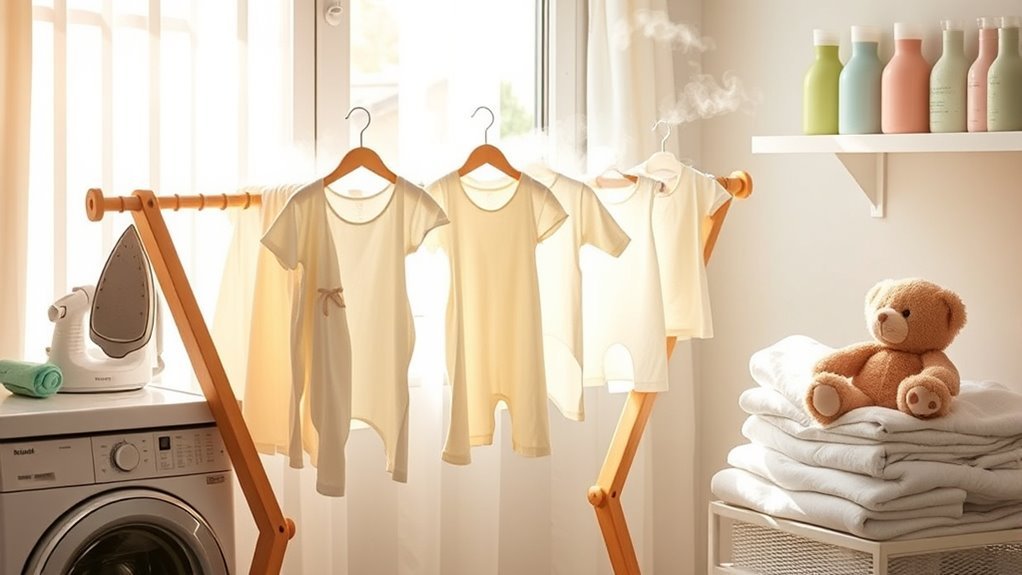
Keeping your baby’s toys clean is just one part of maintaining a healthy environment. Washing baby clothes and fabrics is equally essential. You want to avoid harsh chemicals that limit your freedom to choose safe products. Skip fabric softeners with strong scents; they can irritate sensitive skin. Instead, opt for gentle, hypoallergenic options. For those inevitable messes, use baby-friendly stain removers that work without compromising safety.
| Task | Tips |
|---|---|
| Washing | Use mild detergent, warm water |
| Stain Removal | Apply gentle, baby-safe remover |
| Softening | Avoid strong fabric softeners |
Maintaining Nursery Bedding and Linens
Since nursery bedding and linens come into direct contact with your baby’s delicate skin, you’ll want to clean them regularly using gentle methods. Start by choosing bedding materials that are breathable and hypoallergenic, like organic cotton or bamboo, to reduce irritation. Stick to a simple washing routine—use warm water and avoid harsh detergents to keep fabrics soft and safe. To maintain nursery organization, designate a specific area for clean linens to prevent cross-contamination. Rotate bedding frequently so you always have fresh items ready without piling up laundry. Remember, keeping bedding clean not only protects your baby’s sensitive skin but also creates a comfortable, inviting space that supports their freedom to explore and rest peacefully. Simple, consistent care goes a long way in maintaining a healthy nursery environment.
Choosing Safe Cleaning Products for Baby Items
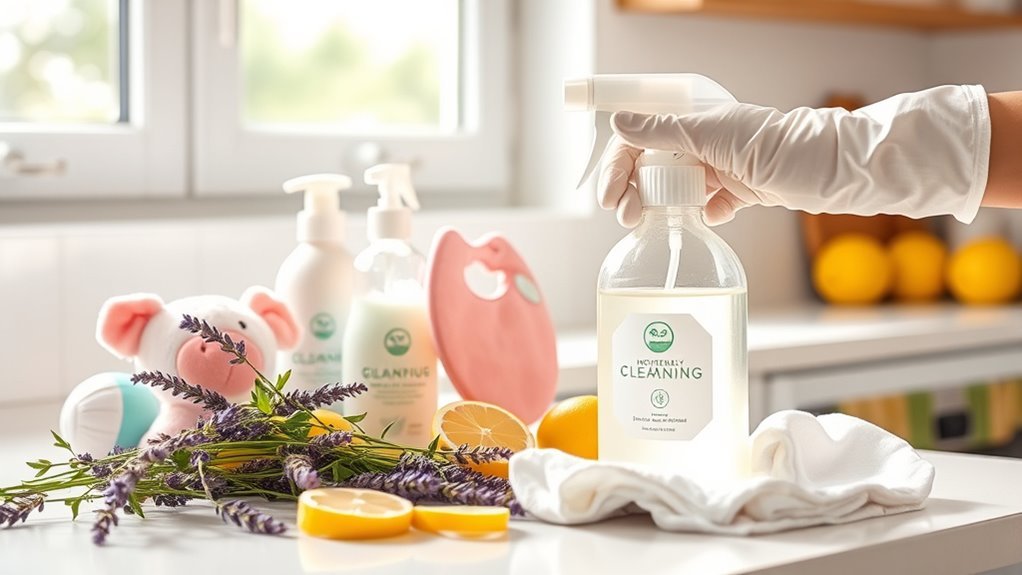
When selecting cleaning products for baby items, you’ll want to prioritize those free from harsh chemicals and fragrances that could irritate your little one’s sensitive skin. Choosing natural alternatives lets you clean effectively without exposing your baby to potentially harmful toxins. Look for products labeled as hypoallergenic and plant-based, which often offer gentle yet powerful cleaning. Eco friendly solutions not only protect your baby but also support a healthier planet, giving you the freedom to care for your family responsibly. You can even make simple homemade cleaners using ingredients like vinegar and baking soda to guarantee safety and control over what touches your baby’s belongings. By opting for these mindful choices, you create a safer environment while embracing a lifestyle that values both your child’s well-being and environmental health.
Tips for Regular Disinfection and Hygiene Practices
Although it might seem overwhelming, establishing regular disinfection and hygiene routines for baby items is easier than you think. Keeping these routines simple helps protect your baby’s health and supports effective germ prevention without taking up all your time.
Here are some straightforward tips you can follow:
| Task | Frequency |
|---|---|
| Wash pacifiers and bottles | Daily |
| Disinfect toys | Weekly |
| Clean changing mats | After each use |
| Sanitize high chairs | After each meal |
| Hand hygiene before handling | Every time |
Frequently Asked Questions
How Often Should I Replace Baby Pacifiers?
You should replace baby pacifiers every 4 to 6 weeks to maintain good pacifier hygiene and guarantee your little one’s safety. Pacifier lifespan varies, but wear and tear can harbor germs or cause choking hazards. If you notice cracks or discoloration, swap it out immediately. Staying on top of this lets you keep your baby healthy while enjoying the freedom of worry-free comfort for your child.
Can I Use Vinegar to Clean Baby Items?
You can use vinegar to clean baby items because vinegar benefits include its natural antibacterial properties and being non-toxic, making it a safe choice. However, you might want to mix it with water and avoid using it on sensitive materials. If vinegar isn’t your style, there are plenty of cleaning alternatives like mild soap or baby-specific wipes that give you freedom to pick what works best for you and your little one.
Are UV Sterilizers Safe for Baby Products?
You might wonder if UV sterilizers are safe for baby products. They’re generally effective at killing germs because UV light safety standards guarantee they don’t emit harmful radiation when used properly. Just make certain you follow the manufacturer’s guidelines to avoid overexposure. UV sterilizer effectiveness depends on proper use, but they offer a convenient, chemical-free way to keep your baby’s items clean while giving you the freedom to skip harsh cleaners.
How to Clean Baby Car Seats and Strollers?
Cleaning your baby car seats and strollers can feel like a Herculean task, but it’s essential for car seat maintenance and stroller care. Start by vacuuming crumbs and dirt, then spot-clean with mild soap and water. Avoid harsh chemicals that can damage fabrics or safety features. For removable covers, follow washing instructions. Regular care keeps things fresh and lets you enjoy worry-free adventures with your little one, giving you the freedom to explore without stress.
What’S the Best Way to Dry Baby Items After Cleaning?
When it comes to drying baby items, air drying is usually your safest bet—it keeps things fresh and avoids any heat damage. You can hang clothes or lay them flat in a well-ventilated space. If you prefer machine drying, just make sure to check the care labels first. Some items handle low heat well, but others might shrink or lose shape. Trust your instincts and pick the method that gives you freedom without risking your baby’s stuff.
